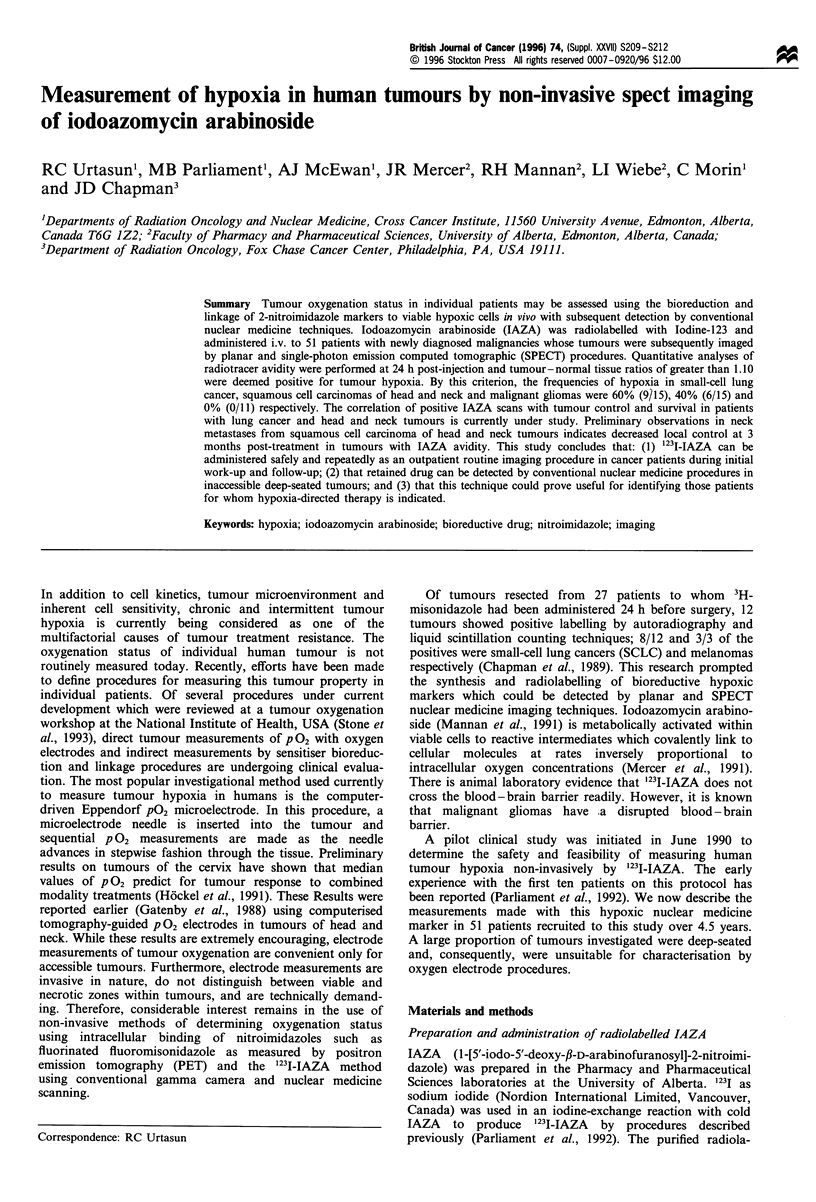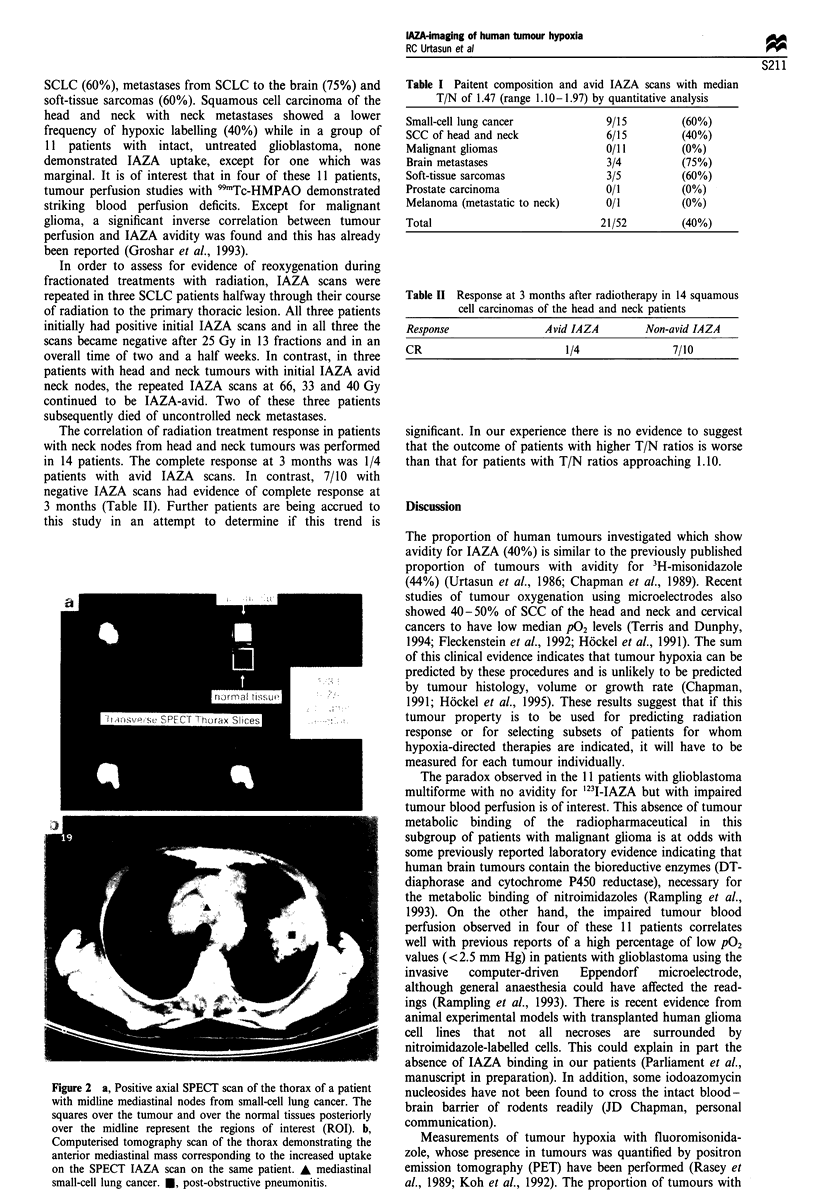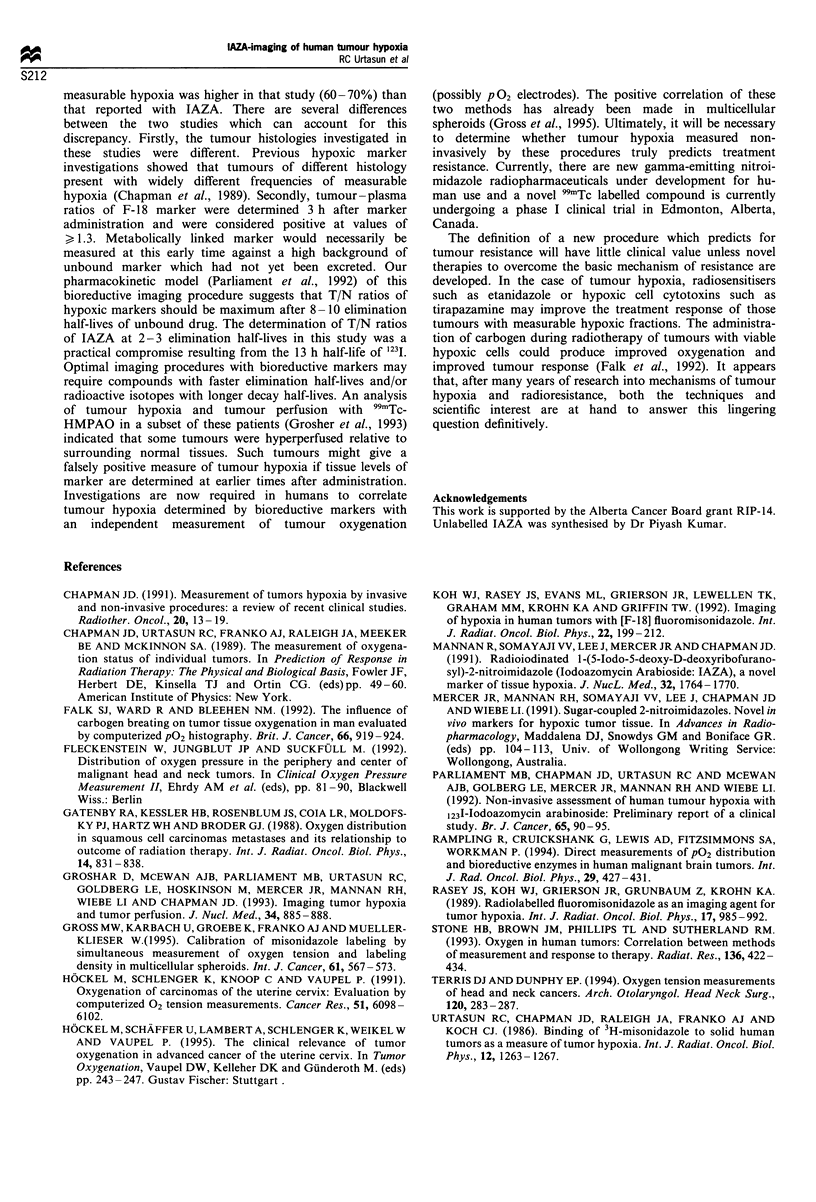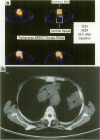Abstract
Tumour oxygenation status in individual patients may be assessed using the bioreduction and linkage of 2-nitroimidazole markers to viable hypoxic cells in vivo with subsequent detection by conventional nuclear medicine techniques. Iodoazomycin arabinoside (IAZA) was radiolabelled with Iodine-123 and administered i.v. to 51 patients with newly diagnosed malignancies whose tumours were subsequently imaged by planar and single-photon emission computed tomographic (SPECT) procedures. Quantitative analyses of radiotracer avidity were performed at 24 h post-injection and tumour-normal tissue ratios of greater than 1.10 were deemed positive for tumour hypoxia. By this criterion, the frequencies of hypoxia in small-cell lung cancer, squamous cell carcinomas of head and neck and malignant gliomas were 60% (9/15), 40% (6/15) and 0% (0/11) respectively. The correlation of positive IAZA scans with tumour control and survival in patients with lung cancer and head and neck tumours is currently under study. Preliminary observations in neck metastases from squamous cell carcinoma of head and neck tumours indicates decreased local control at 3 months post-treatment in tumours with IAZA avidity. This study concludes that: (1) 123I-IAZA can be administered safely and repeatedly as an outpatient routine imaging procedure in cancer patients during initial work-up and follow-up; (2) that retained drug can be detected by conventional nuclear medicine procedures in inaccessible deep-seated tumours; and (3) that this technique could prove useful for identifying those patients for whom hypoxia-directed therapy is indicated.
Full text
PDF



Images in this article
Selected References
These references are in PubMed. This may not be the complete list of references from this article.
- Chapman J. D. Measurement of tumor hypoxia by invasive and non-invasive procedures: a review of recent clinical studies. Radiother Oncol. 1991;20 (Suppl 1):13–19. doi: 10.1016/0167-8140(91)90181-f. [DOI] [PubMed] [Google Scholar]
- Falk S. J., Ward R., Bleehen N. M. The influence of carbogen breathing on tumour tissue oxygenation in man evaluated by computerised p02 histography. Br J Cancer. 1992 Nov;66(5):919–924. doi: 10.1038/bjc.1992.386. [DOI] [PMC free article] [PubMed] [Google Scholar]
- Gatenby R. A., Kessler H. B., Rosenblum J. S., Coia L. R., Moldofsky P. J., Hartz W. H., Broder G. J. Oxygen distribution in squamous cell carcinoma metastases and its relationship to outcome of radiation therapy. Int J Radiat Oncol Biol Phys. 1988 May;14(5):831–838. doi: 10.1016/0360-3016(88)90002-8. [DOI] [PubMed] [Google Scholar]
- Groshar D., McEwan A. J., Parliament M. B., Urtasun R. C., Golberg L. E., Hoskinson M., Mercer J. R., Mannan R. H., Wiebe L. I., Chapman J. D. Imaging tumor hypoxia and tumor perfusion. J Nucl Med. 1993 Jun;34(6):885–888. [PubMed] [Google Scholar]
- Gross M. W., Karbach U., Groebe K., Franko A. J., Mueller-Klieser W. Calibration of misonidazole labeling by simultaneous measurement of oxygen tension and labeling density in multicellular spheroids. Int J Cancer. 1995 May 16;61(4):567–573. doi: 10.1002/ijc.2910610422. [DOI] [PubMed] [Google Scholar]
- Höckel M., Schlenger K., Knoop C., Vaupel P. Oxygenation of carcinomas of the uterine cervix: evaluation by computerized O2 tension measurements. Cancer Res. 1991 Nov 15;51(22):6098–6102. [PubMed] [Google Scholar]
- Koh W. J., Rasey J. S., Evans M. L., Grierson J. R., Lewellen T. K., Graham M. M., Krohn K. A., Griffin T. W. Imaging of hypoxia in human tumors with [F-18]fluoromisonidazole. Int J Radiat Oncol Biol Phys. 1992;22(1):199–212. doi: 10.1016/0360-3016(92)91001-4. [DOI] [PubMed] [Google Scholar]
- Mannan R. H., Somayaji V. V., Lee J., Mercer J. R., Chapman J. D., Wiebe L. I. Radioiodinated 1-(5-iodo-5-deoxy-beta-D-arabinofuranosyl)-2-nitroimidazole (iodoazomycin arabinoside: IAZA): a novel marker of tissue hypoxia. J Nucl Med. 1991 Sep;32(9):1764–1770. [PubMed] [Google Scholar]
- Parliament M. B., Chapman J. D., Urtasun R. C., McEwan A. J., Golberg L., Mercer J. R., Mannan R. H., Wiebe L. I. Non-invasive assessment of human tumour hypoxia with 123I-iodoazomycin arabinoside: preliminary report of a clinical study. Br J Cancer. 1992 Jan;65(1):90–95. doi: 10.1038/bjc.1992.17. [DOI] [PMC free article] [PubMed] [Google Scholar]
- Rampling R., Cruickshank G., Lewis A. D., Fitzsimmons S. A., Workman P. Direct measurement of pO2 distribution and bioreductive enzymes in human malignant brain tumors. Int J Radiat Oncol Biol Phys. 1994 Jun 15;29(3):427–431. doi: 10.1016/0360-3016(94)90432-4. [DOI] [PubMed] [Google Scholar]
- Rasey J. S., Koh W. J., Grierson J. R., Grunbaum Z., Krohn K. A. Radiolabelled fluoromisonidazole as an imaging agent for tumor hypoxia. Int J Radiat Oncol Biol Phys. 1989 Nov;17(5):985–991. doi: 10.1016/0360-3016(89)90146-6. [DOI] [PubMed] [Google Scholar]
- Stone H. B., Brown J. M., Phillips T. L., Sutherland R. M. Oxygen in human tumors: correlations between methods of measurement and response to therapy. Summary of a workshop held November 19-20, 1992, at the National Cancer Institute, Bethesda, Maryland. Radiat Res. 1993 Dec;136(3):422–434. [PubMed] [Google Scholar]
- Terris D. J., Dunphy E. P. Oxygen tension measurements of head and neck cancers. Arch Otolaryngol Head Neck Surg. 1994 Mar;120(3):283–287. doi: 10.1001/archotol.1994.01880270031006. [DOI] [PubMed] [Google Scholar]
- Urtasun R. C., Chapman J. D., Raleigh J. A., Franko A. J., Koch C. J. Binding of 3H-misonidazole to solid human tumors as a measure of tumor hypoxia. Int J Radiat Oncol Biol Phys. 1986 Jul;12(7):1263–1267. doi: 10.1016/0360-3016(86)90273-7. [DOI] [PubMed] [Google Scholar]




